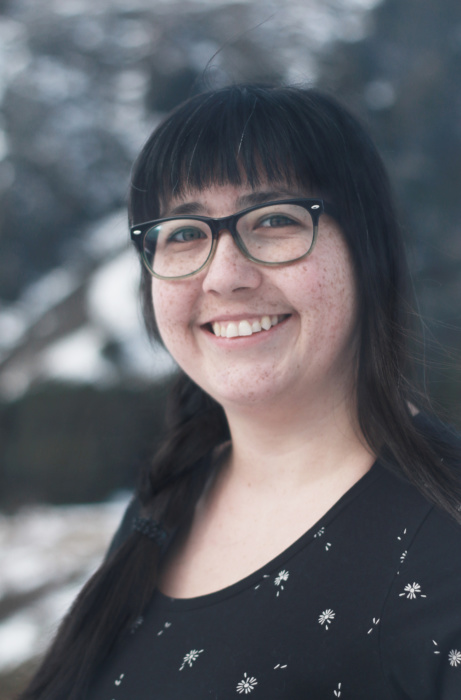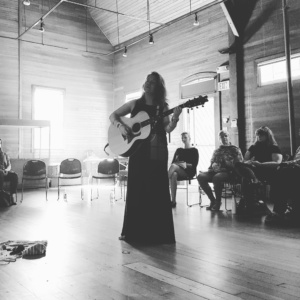tet; mâni; ute | here
tet; mâni; ute|here : Melissa Tremblett & John Jeddore
Curated by Joanna Barker
April 21st – June 2nd, 2018

In 1949, the Terms of Union between Newfoundland and Canada failed to acknowledge all Indigenous communities on both the island and mainland portion of the province that is now NL. This exclusion has often been referenced as Joey Smallwood directly saying that ‘there are no Indians here’. Though those words were never said verbatim, they were believed to have been spoken and have been misquoted by Indigenous and non-Indigenous members of our province for generations. The destructive cultural, social and emotional ramifications of this claim have been longstanding.
In this exhibition, curator Joanna Barker poses the question to artist Melissa Tremblett and photographer John Jeddore – if there were no Indians here, where were you?

Melissa Tremblett is an artist of First Nation and European descent. She is a mixed media artist who works primarily with textiles, photography, and printmaking. Context changes and social shifts from travelling between various towns in Newfoundland and her home community of Sheshatshiu, Labrador, influence her work today. Melissa is currently living in Corner Brook.
 John Jeddore is a Mi’kmaw photographer, and member of Miawpukek First Nation (Conne River). He is currently a Neurology resident with the Faculty of Medicine, Memorial University of Newfoundland and Labrador, which focus on disorders of the brain and spinal cord. John has spent considerable time on revitalizing and encouraging Mi’kmaq language use and learning among Indigenous youth in NL. He believes that cultural identity is deeply intertwined within the world-view that accompanies a Nation’s language.
John Jeddore is a Mi’kmaw photographer, and member of Miawpukek First Nation (Conne River). He is currently a Neurology resident with the Faculty of Medicine, Memorial University of Newfoundland and Labrador, which focus on disorders of the brain and spinal cord. John has spent considerable time on revitalizing and encouraging Mi’kmaq language use and learning among Indigenous youth in NL. He believes that cultural identity is deeply intertwined within the world-view that accompanies a Nation’s language.
 JOANNA BARKER
JOANNA BARKER
An essay by Joanna Barker regarding the show:
Mi’kmaq -– tet
Labrador dialect Inuktitut –- mâni
Labrador dialect Innu-aimun –- ute
English — here
Don’t Get Us Wrong This Time
I have a vivid memory of one day in my Grade 6 Language Arts class when our teacher stood at the chalkboard and asked us to list off ways in which we learn about a character in a story. Our class came up with a list that looked something like this,
Ways a reader can learn about a character
1. What the character says.
2. What the character does.
3. What the narrator says about the character.
4. What other characters say about the character.
That last one really struck me — what other characters say about the character. What other people say about you.
To me, there was a glaringly obvious problem with this method of learning about people in stories, or in real life, and so I asked, “but what if the other people got the character’s story wrong? What if they’ve got you wrong?”
How often are we wrongfully defined by misinformation? What does this even look like in real life?
For the Mi’kmaq, Inuit and Innu people of Newfoundland and Labrador, being wrongfully defined by misinformation is unfortunately an injustice that is all too familiar.
In 1949, the Terms of Union between Newfoundland and Canada failed to acknowledge all Indigenous communities on both the island and mainland portion of the province that is now NL. This exclusion has often been referenced to as our province’s first premier, Joey Smallwood, directly saying that ‘there are no Indians here’. Though those words were never said verbatim, they were believed to have been spoken and have been misquoted by Indigenous and non-Indigenous members of our province for generations. The destructive cultural, social and emotional ramifications of this wrongful claim have been longstanding and divisive.
For this exhibition, tet; mâni; ute|here, I posed the question to artist Melissa Tremblett and photographer John Jeddore – if there were no Indians here, where were you?
Melissa and John are rewriting the archive with their story, the story of their families and the families in their community. These artists are coming forward to say – we have been wrongfully defined by misinformation. You’ve got us wrong – listen to what we say about ourselves and don’t get us wrong this time.
This exhibition provides a rare and intimate opportunity for those who visit the gallery to witness the telling of stories of some of this land’s Indigenous peoples, on their terms and in a way that they feel comfortable sharing them. As for the lesson from my Grade 6 character study, visitors are also invited and encouraged to learn from what these artists say about themselves, and from what they do, rather than focusing on what other people have said about them.
– Joanna Barker
This is one of the 200 exceptional projects funded through the Canada Council for the Arts’ New Chapter program. With this $35M investment, the Council supports the creation and sharing of the arts in communities across Canada.
Ce projet est l’un des 200 projets exceptionnels soutenus par le programme Nouveau chapitre du Conseil des arts du Canada. Avec cet investissement 35 M$, le Conseil des arts appuie la création et le partage des arts au cœur de nos vies et dans l’ensemble du Canada.
Eastern Edge would like to further acknowledge the generous support provided by, Flotilla and The Averbach Foundation.
